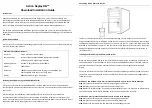
All rights reserved. Reproduction as well as electronic duplication of this user guide, complete or in part, requires the written consent of
ESERA GmbH. Errors and technical modification subject to change.
ESERA GmbH, ESERA-Automation 2020
www.esera.de
11132 V2.0 R1.0 Manual
Page 4 of 5
13
pin assignment
The 1-Wire Multisensor is connected via screwless pressure
clamps. The terminal pin assignment is printed on the printed
circuit board.
The terminals are intended for solid cables with a cross-section of
0.2 to 2.5qmm or flexible cables with a cross-section of 0.2 to
1.5qmm. The correct polarity of the connection must be observed.
The 1-Wire Multisensor must be supplied with three cables
(ground, 1-Wire Data and 5V). The parasitic mode is not
supported
.
Note: Basics and tips for the 1-Wire bus system can be found on
the ESERA website at
https://www.esera.de/1-wire-grundlagen/
14
Assembly
The installation site must be protected from moisture. The device is intended for installation inside a building as a
stationary device. Draughts through cable conduits can falsify the measured values. An airtight closure of the
cable conduits avoids this effect.
The 1-Wire Multisensor must be mounted so that the ventilation openings of the central plate are open upwards
and downwards.
15
Operating conditions
The module may only be operated at the specified voltages and ambient conditions. The device is intended for
use in dry areas.
If condensation forms inside the multisensor, wait at least 2 hours before acclimatizing. Do not operate the
module in an environment in which flammable gases, vapours or dusts are present or may be present.
16
Disposal instructions
Do not dispose of the device in domestic waste! Electronic devices are to be disposed of
according to the Directive on waste electrical and electronic equipment (WEEE) on local
authorities and collection points for waste electronic equipment!
17
Safety Instructions
When using products that come into contact with electrical voltage, the valid VDE regulations must be
observed, especially VDE 0100, VDE 0550/0551, VDE 0700, VDE 0711 and VDE 0860
All final or wiring work must be carried out with the power turned off.
Before opening the device, always unplug or make sure that the unit is disconnected from the mains.
Components, modules or devices may only be put into service if they are mounted in a contact proof housing.
During installation they must not have power applied.
Tools may only be used on devices, components or assemblies when it is certain that the devices are disconnected
from the power supply and electrical charges stored in the components inside the device have been discharged.
Live cables or wires to which the device or an assembly is connected, must always be tested for insulation faults or
breaks.
If an error is detected in the supply line, the device must be immediately taken out of operation until the faulty cable
has been replaced.
When using components or modules it is absolutely necessary to comply with the requirements set out in the
accompanying description specifications for electrical quantities.
If the available description is not clear to the non-commercial end-user what the applicable electrical characteristics
for a part or assembly are, how to connect an external circuit, which external components or additional devices can
be connected or which values these external components may have, a qualified electrician must be consulted.
It must be examined generally before the commissioning of a device, whether this device or module is basically
suitable for the application in which it is to be used.
In case of doubt, consultation with experts or the manufacturer of the components used is absolutely necessary.
For operational and connection errors outside of our control, we assume no liability of any kind for any resulting
damage.
Kits should be returned without their housing when not functional with an exact error description and the
accompanying instructions. Without an error description it is not possible to repair. For time-consuming assembly or
disassembly of cases charges will be invoiced.
During installation and handling of components which later have mains potential on their parts, the relevant VDE
regulations must be observed.
Devices that are to be operated at a voltage greater than 35 VDC / 12mA, may only be connected by a qualified
electrician and put into operation.























